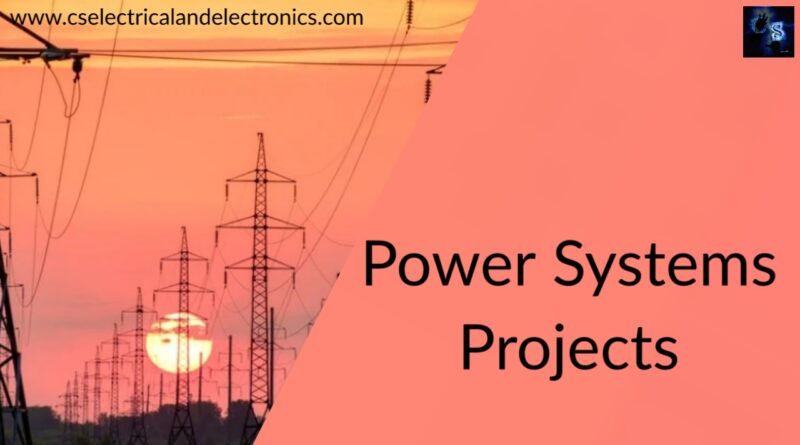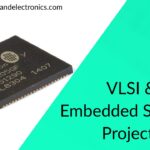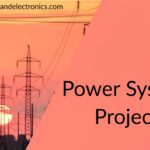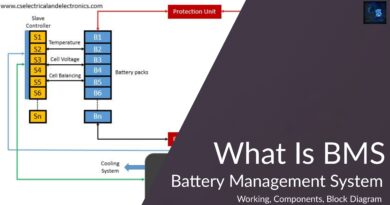Top 20 Power Systems Projects For MTech Students, Engineering Students
Hello guys, welcome back to my blog. In this article, I will discuss the top 20 power system projects for MTech students, engineering students, or projects on power systems for electrical and electronics engineers.
If you have any doubts related to electrical, electronics, and computer science, then ask questions. You can also catch me on Instagram – Chetan Shidling.
Also, read:
- Top 10 3D Designing Tools for Engineering Students, Tools For 3D Design
- Top Websites For Online Courses In The World, Online Course Website
- Top 10 Universities For MS In The World, MS Universities In The World
Top 20 Power Systems Projects For MTech Students
Electrical engineering is a field of engineering concerned with the generation, distribution, and use of electricity. Power systems is a specific branch of Electrical Engineering that studies these topics. The Master of Engineering in Power Systems program delves into the subject in depth. We’ll talk about the Top 20 Power System Projects for Mtech Students here:
01. Analysis of distributed demand flow in the power grid
The vast power system may be divided into numerous tiny sections for load flow study. Distributed computing is another enhancement that improves the performance of load flow analysis. To save time and computational burden, a complex load flow algorithm might be divided into many parts and executed on multiple computers.
02. Using a Phasor Measurement Unit to monitor the power system
The phasor measuring unit (PMU) monitors voltage and angle and sends the data to a centralized site with a satellite time stamp. As a result, the measured value from a PMU will be timestamped, making analysis easier. A PMU offers several benefits over a power system monitoring system based on a Scada.
03. Power system harmonic reduction
The harmonics are responsible to alter the output parameter. If more harmonics are present in the circuit then the circuit will not produce the desired output. Harmonics are present in both ac and dc supply. The harmonics are nothing but an unwanted signal that will change the output signal.
04. Using STATCOM, improve the grid’s transient stability
The STATCOM (Static Synchronous Compensator) is a shunt device from the Flexible AC Transmission Systems (FACTS) family that uses power electronics to regulate power flow and increase grid transient stability.
05. The impact of vehicle-to-grid technology on electricity quality
Vehicle to Grid (V2G) is a system that connects electric vehicles to the power grid, not only for charging but also to supply electric energy to the grid when needed. Electric vehicles are a big load that has an impact on electricity quality.
When an electric vehicle is linked to the grid, it has a direct impact on the voltage, current, and power factor. Harmonics are injected into the grid via a power electronics converter.
06. Vehicle-to-Grid (V2G) is a peak load control strategy
The car to grid approach for peak load control is another project field that we may add to the list of power system projects. Electric vehicles will become more prevalent soon. To charge the battery, they connect to the electrical grid. The bidirectional charger of an electric car linked to the grid would assist in reducing peak-hour power usage.
07. Integration of renewable energy sources into the electrical grid
Micro generators generate electricity from a variety of sources and have a great potential for grid connection. Distributed generation refers to the generation of energy at or near the load center itself.
Due to the development of solar, wind, biogas, and other kinds of energy production, the traditional technique of generating power at a place and transmitting it to the demand is progressively changing.
08. Fuzzy-proportional integral compensated zero/minimum active power algorithm based dynamic voltage restorer with self-tuned fuzzy proportional integral compensation
Due to its negative impact on modern sensor technology, voltage sag has become the most prevalent and serious power quality problem in recent years. In general, this occurrence is caused by three-phase induction motor (IM) direct-on-line starting and different types of short circuit faults.
09. DVR and DSTATCOM comparative simulation results to improve voltage quality in distributed power systems
This research compares the performance of a Dynamic Voltage Restorer (DVR) with a Distributed Static Synchronous Compensator in improving the voltage profile of a distributed power system (D-STATCOM). The distributed power grid is presented using the IEEE benchmark 13-bus distributed power system.
10. A resonant control scheme with two degrees of freedom for voltage sag compensation in dynamic voltage restorers
Two degrees of freedom (2DOF) control system for voltage compensation in a dynamic voltage restorer is shown in this research (DVR). It starts with a model of the DVR power circuit, which serves as the foundation for the control design process.
11. Design of an external inductor for improving voltage-controlled DSTATCOM performance
For load voltage control, a distribution static compensator (DSTATCOM) is employed, and its effectiveness is largely determined by the feeder impedance and its type (resistive, inductive, stiff, non-stiff). However, there isn’t well-defined research for assessing DSTATCOM voltage
regulation performance about network factors.
12. Improving power quality in distribution networks with DSTATCOM and a battery energy storage system
The distribution static compensator (DSTATCOM) enables load adjustment, harmonics current removal, voltage flicker reduction, and voltage and frequency regulation by providing rapid control of active and reactive powers. This study uses DSTATCOM with a battery energy storage system to improve power quality in the presence of grid disruptions and wind energy penetration.
13. The proportional resonance controller is used to control three-phase grid-connected PV inverters
The necessity of attaining a low distortion and high-quality current waveform has grown as the grid-connected three-phase inverters have progressed. This paper discusses how to use a Proportional Resonance (PR) controller to reduce current ripple in a three-phase grid-connected inverter.
14. Adaptive PR controller for current control of three-phase grid-connected PV inverters
The number of grid-connected three-phase inverter systems connected to the distribution network has increased dramatically in recent years. As a result, high-quality, low-harmonic distortion power and grid current injection are critical.
15. A hysteresis current controller with reduced losses for a grid-connected inverter
This research proposes a three-phase grid-connected inverter hysteresis current controller with decreased losses. Depending on the polarity of the phase current, one of the inverter phases is clamped to the positive or negative inverter buses in the proposed hysteresis current controller.
16. Multiconverter unified power-quality conditioning system: MC-UPQC
This research introduces the MC-UPQC, a novel unified power-quality-conditioning system capable of simultaneous voltage and current correction in multibus/multi-feeder systems. One shunt voltage-source converter (shunt VSC) and two or more series VSCs are included in this arrangement.
17. Dynamic voltage restorer based on artificial neural networks for improving power quality
The Dynamic Voltage Restorer (DVR) is a bespoke power device that is used to safeguard sensitive loads in power distribution systems from voltage fluctuations. The DVR efficiency is determined by the efficiency of the control method that performs the inverter switching.
18. Current harmonics hysteresis current controller with offset band reduction of three-phase grid-connected pulse width modulated voltage source inverter
The advancement of power electronics technology has created several opportunities for renewable energy grid integration. For this, a pulse width modulated voltage source inverter is commonly employed. Grid integrated inverter control techniques play a critical role in reducing harmonics and improving power quality in the system.
19. Application of an ANN-based MPPT to a solar-powered water pumping system with a BLDC motor
This research applies the maximum power point tracking (MPPT) approach of a non-electrical input-based artificial neural network (ANN) to a solar-powered water pumping system employing a brushless DC (BLDC) motor. The goal is to use a neural network to simulate a stepsize independent MPPT for a water pumping application.
20. Improved fault ride-through capability in DFIG based wind turbines with combined feed-forward and feed-back control using dynamic voltage restorer
Using a dynamic voltage restorer, this research examines how a doubly-fed induction generator (DFIG)-based wind turbine may increase its fault ride-through (FRT) capacity (DVR).
To summarize, this page explains power system projects for electrical engineering students. These are merely suggestions for developing/finding project ideas. You might consider these concepts and create new electrical projects in the field of power systems.
I hope this article ” Top 20 Power Systems Projects For MTech Students ” may help you all a lot. Thank you for reading ” Top 20 Power Systems Projects For MTech Students “.
Also, read:
- 10 Tips To Maintain Battery For Long Life, Battery Maintainance
- 10 Tips To Save Electricity Bills, Save Money By Saving Electricity
- 100 (AI) Artificial Intelligence Applications In The Automotive Industry
- 100 + Electrical Engineering Projects For Students, Engineers
- 1000+ Control System Quiz, Top MCQ On Control System
- 1000+ Electrical Machines Quiz, Top MCQs On Electrical Machines
- 1000+ Electronics Projects For Engineers, Diploma, MTech Students
- 1000+ MATLAB Simulink Projects For MTech, Engineering Students
Author Profile
- Content Writer
Latest entries
 All PostsAugust 25, 2021Top 16 Highest Paying Engineering Jobs in the USA For Freshers
All PostsAugust 25, 2021Top 16 Highest Paying Engineering Jobs in the USA For Freshers All PostsAugust 23, 2021Top 10 Smart Cities In The World, Best Cities To Visit In The World
All PostsAugust 23, 2021Top 10 Smart Cities In The World, Best Cities To Visit In The World All PostsAugust 21, 2021Top 20 VLSI & Embedded Systems Projects for Mtech Students
All PostsAugust 21, 2021Top 20 VLSI & Embedded Systems Projects for Mtech Students All PostsAugust 21, 2021Top 20 Power Systems Projects For MTech Students, Engineering Students
All PostsAugust 21, 2021Top 20 Power Systems Projects For MTech Students, Engineering Students








